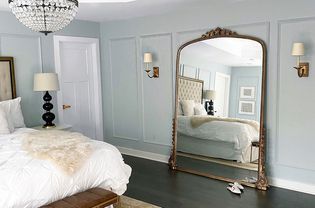A French word meaning "linen cloth" or "canvas," toile is a type of canvas-like fabric that has been a popular decorating element since the mid-1700s. The term "toile" can have a few different meanings, including the canvas-like fabric itself, a repeated pattern on the fabric, or a test garment made from the fabric. For decorating purposes, however, "toile" refers to a pattern repeated on the fabric. Typically, the pattern depicts a highly complex, detailed, pastoral scene with colors like blue, green, or red in patterns over a white or beige background.
Pronounced "twall," toile has a long, varied history across Europe and the United States. The fabric originated in Ireland sometime during the mid-1700s but became an extremely popular decorating element across Britain and France. Despite its Irish origins, the term "Toile de Jouy," meaning "cloth from Jouy-en-Josas"—a suburb of Paris—originated in France during the late 18th century.
After several hundred years of history, toile has a reputation as being a "stuffy" or outdated decorating element. Its popularity has ebbed and flowed over the years—with major surges in the 1700 and 1800s, Colonial America, the 1970s, and again in the 2000s—but toile has remained a classic decorating element that can still be found in homes across the world.
The History of Toile
As previously mentioned, toile was first developed in Ireland at some point during the 1700s. Originally, toile was used by a dressmaker or tailor to test a pattern on cheap, white, or off-white fabric. Usually, the designer would create multiple toiles until the pattern was perfect.
Although toile originally had Irish origins, it became a well-known product of France. In 1760, Christophe-Philippe Oberkampf opened the first toile factory in Jouy-en-Josas, France, and the material was redubbed "Toile de Jouy." Oberkampf worked with the famous designer Jean-Baptiste Huet to develop the classic patterns and styles of toile, which can still be found today.
Printed on white or off-white canvas or linen, toile often depicted a detailed pastoral scene, floral arrangements, and other images inspired by nature. The pattern was usually printed in a single color, like black, red, or blue, but brighter colors, like green or magenta, could occasionally be found.
:max_bytes(150000):strip_icc()/GettyImages-165771518-6b8ab9a4f7cf43948495c5b3761b1c74.jpg)
Over time, toile became most closely associated with upholstery in the home. Think: pillows, bedding, curtains, and upholstery for furniture. Toile wallpaper and toile clothing also became popular—the latter, especially, for high-class functions, like garden or tea parties.
Settlers brought toile to North America during the Colonial Era, where it became a much sought-after item. Colonial Era toile is often found in American historical sites, like Williamsburg, Virginia. In fact, when Williamsburg experienced a surge in popularity during the 1930s, toile also experienced a resurgence. The same occurred during the 1970s, when America celebrated its bicentennial.
While toile has been continuously produced since its inception in 1700s Ireland, its popularity has peaked and valleyed over the last 400 years. Aside from its major resurgences in the 1930s and 1970s, many clothing designers began to incorporate toile into clothing patterns and styles in the 2000s. Many home decor producers continue to design and develop toile home goods today.
Characteristics of Toile
Some identifying characteristics of toile include:
- A pattern printed on white or off-white canvas, linen, or muslin material: Because the original dressmakers and tailors had used several sheets of toile fabric to perfect their pattern, they needed an extremely cheap, unbleached material.
- A highly detailed, repeated pattern depicting a pastoral or natural scene: Flowers, couples, animals, and landscapes are often the subject of classic toile patterns.
- Patterns printed in simple, but bold colors: Early toile patterns were printed in black, red, blue, green, magenta, or brown ink, but today's toile can be found in countless color variations.
How to Decorate With Toile
Incorporating toile into your home decor gives your home a cozy, "shabby chic" or "French country" vibe. Toile's popularity has also resurfaced with updated designs depicting modern, less pastoral-themed scenes for all ages that fit into more contemporary decor. Here are some ideas of how to use toile in your home.
- Upholstery: Toile patterns make a great addition to upholstery on accent chairs, dining cushions, or even outdoor furniture. Use toile upholstery in bright colors to add contrast to neutral designs, or opt for more toned-down toile hues to tie your accent colors in with the rest of the room.
- Bedding: Toile bedding in its varied colors works for all types of bedrooms. A bedding set with a black or gray toile print on a cream background offers a more dramatic, moody aesthetic. For a softer look in the bedroom, go with blue or pink toile on cream. Rather than mixing and matching toile prints and colors, keep them consistent and coordinated throughout a room for a unified, less busy look.
- Throw Pillows and Blankets: Toile patterns on accessories such as pillows, blankets, and throws bring a charming and classic note to solid or textured neutral sofas, chairs, and bedding. It's okay to mix in other prints, such as plaids or stripes, with toile, and it works especially well if all the patterns are in the same color scheme.
- Window Treatments: For a peek of toile, layer sheer toile curtains under heavier neutral drapery panels. Sheer and airy toile curtains alone bring a breezy French country farmhouse feel to any room. Use a more modern multicolored toile pattern for drapery panels to accent a room filled with neutral furnishings or bedding.
- Wallpaper: Use toile wallpaper to create a statement wall in your living room, dining room, bedroom, or small bathroom. Tone down the toile with a neutral paint color for the other walls.
- China and Pottery: If you want a touch of toile, opt for accessories with a toile pattern such as ceramic ginger jars, vases, planters, or decorative bowls and dishes. Coordinate an accessory in the same color as a toile toss pillow or upholstered piece to tie the room together.
- Artwork: Pair toile artwork of pastoral scenes in a gold frame for a most classic and luxurious look. Even a piece of remnant toile fabric tightly wrapped around a gallery canvas DIY-style instantly elevates a room's elegance.
:max_bytes(150000):strip_icc()/donnelly-headshot-5b720013c9e77c00504bb502-b0e1053c0875458e951148b930bd93ac.jpg)
:max_bytes(150000):strip_icc()/GettyImages-183026676-66b27942612346b2ac88aa80cca7065b.jpg)

